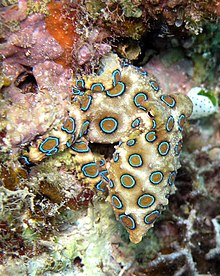
Back أخطبوط أزرق الحلقات Arabic اخطبوط ازرق الحلقات ARZ Hapalochlaena AST هاپالوچلانا AZB Синьопръстенни октоподи Bulgarian Hapalochlaena CEB Hapalochlaena Czech Blaugeringelte Kraken German Hapalochlaena Spanish Siniring-kaheksajalg ET
| Blue-ringed octopus | |
|---|---|

| |
| Greater blue-ringed octopus (Hapalochlaena lunulata) | |
| Scientific classification | |
| Domain: | Eukaryota |
| Kingdom: | Animalia |
| Phylum: | Mollusca |
| Class: | Cephalopoda |
| Order: | Octopoda |
| Family: | Octopodidae |
| Genus: | Hapalochlaena Robson, 1929[1] |
| Type species | |
| Hapalochlaena lunulata | |
| Species | |
| |
Blue-ringed octopuses, comprising the genus Hapalochlaena, are four extremely venomous species of octopus that are found in tide pools and coral reefs in the Pacific and Indian oceans, from Japan to Australia.[2] They can be identified by their yellowish skin and characteristic blue and black rings that can change color dramatically when the animal is threatened. They eat small crustaceans, including crabs, hermit crabs, shrimp, and other small sea animals.
They are one of the world's most venomous marine animals.[3] Despite their small size—12 to 20 cm (5 to 8 in)—and relatively docile nature, they are very dangerous if provoked when handled because their venom contains a powerful neurotoxin called tetrodotoxin.
The species tends to have a lifespan of approximately two to three years. This may vary depending on factors such as nutrition, temperature, and the intensity of light within its environment.
- ^ Finn, Julian (2017). "Hapalochlaena Robson, 1929". World Register of Marine Species. Flanders Marine Institute. Retrieved 3 February 2018.
- ^ Cite error: The named reference
tinywas invoked but never defined (see the help page). - ^ "Ocean's Deadliest: The Deadliest Creatures – Greater Blue-Ringed Octopus". Animal Planet. Archived from the original on 18 February 2009.